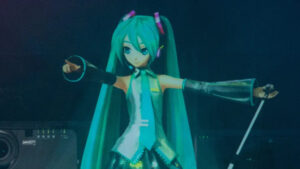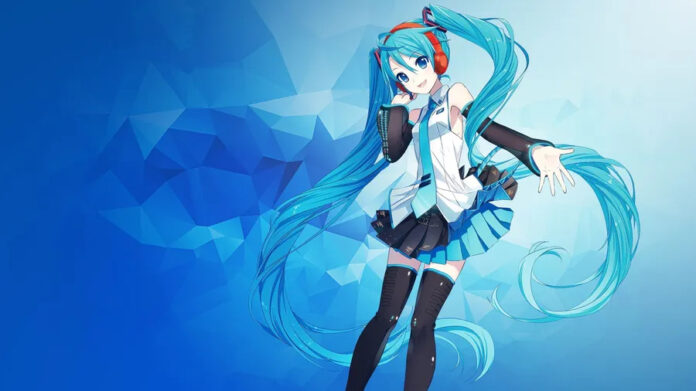She is a global singing sensation, familiar to millions. Some estimates suggest her image and songs have made roughly $120-million, and on August 31st this year, she turned 16. Hatsune Miku is not like other pop stars though. She has always been sixteen, even when she released her first tracks way back in 2007.
Her story starts a few years before those early hits, with a 2004 invention from Yamaha studios called VOCALOIDS – voice synthesizers capable of singing. By using specific voicebanks, users could input lyrics into the software, resulting in the creation of songs. Some notable early VOCALOID models included LEON, LOLA, and MIRIAM (English voicebanks), along with KAITO and MEIKO (Japanese voicebanks). However, these initial releases received only moderate attention.
Crypton Future Media, the company responsible for releasing Yamaha’s Vocaloids, went on to develop their own virtual singer, known as CV01 (Character Vocal Series 01). This creation was based on Yamaha’s Vocaloid 2 technology and featured the voice samples of voice actress Saki Fujita, famous for her role as Ymir in “Attack on Titan.” This ultimately became Hatsune Miku, a name that means “the first sound of the future”.
Hatsune Miku wasn’t just a virtual singer; she was an idol in her own right. Something about her instantly resonated with audiences. She introduced a revolutionary aspect to music production: with a computer and an instrument track, anyone could create a song for her to sing. While LEON and LOLA were better suited for soulful tunes, Miku had a clear and neutral voice that effortlessly adapted to various music genres, including pop, rock, metal, and jazz. If you could imagine it, Miku could sing it.
Miku quickly captured the public’s imagination, leading to a surge in fan art, cosplay, and even marriages to the virtual diva. Her voice became ubiquitous, featuring in songs and short animated videos on platforms like Nico Nico Douga (akin to Japan’s version of YouTube), which later spread to YouTube, solidifying her global stardom.
Once Miku went mainstream, there was no turning back.

She opened for Lady Gaga’s world tour, ArtRave: The Artpop Ball, and received a remix from Pharrell Williams for Livetune’s “Last Night, Goodnight.” Miku’s vocals also graced the soundtrack of “Guardians of the Galaxy Vol. 3” in “Koinu no Carnival” and she even made an appearance on “The Late Show with David Letterman.”
In Sapporo, Japan, the SNOW MIKU festival celebrates her with ice sculptures, and artists worldwide compete to create the official design for each year’s event.
Magical Mirai, an event in Japan, features live concerts and art exhibitions centred around the VOCALOIDs, offering an immersive experience for the VOCALOID community. Miku, alongside her fellow VOCALOIDS like Kagamine Rin and Len, Megurine Luka, Meiko, and Kaito, performs sold-out shows at these events.
Miku has also toured globally through the MIKU EXPO, gracing stages in London, Paris, New York, L.A., Hong Kong, and more. When Miku sang “World is Mine,” she truly meant it.
What makes Miku slightly different to most VOCALOIDS is here ability to appear in front of live audiences using the magic of holograms. Technically, fans can even get Miku to appear at their own homes using a holographic projector or a working Pepper’s ghost illusion.
However, this accessibility is part of what makes Miku special. There’s no fixed lore or character for Miku; she can be anything you imagine. From a cannibal to a lonely high school girl, a survivor in an apocalyptic wasteland to a vendor of vegetable juice, a vampire, or even a girl addicted to MMORPGs, Miku can take on any role.
Initially designed for professional production, Miku found widespread use with the rise of media-sharing platforms, opening up opportunities for aspiring music producers. Many who began as VOCALOID producers, including Kenshi Yonezu, responsible for the “Chainsaw Man” opening “KICK BACK,” have achieved great success.
A fashion icon

Miku’s status as an idol has given rise to an entire subculture. She’s been dressed by Givenchy and featured in Vogue. She’s also the poster girl for Goodsmile Racing, competing in SuperGT. Remarkably, Miku even made her mark in space, with her image engraved on metallic plates aboard the JAXA Akatsuki Venus Climate Orbiter.
Miku has made cameo appearances in various anime series and video games. She has her own manga series, “Maker Hikōshiki Hatsune Mix.” The Project DIVA series of rhythm games predominantly feature her songs. Sony even released a special turquoise Hatsune Miku edition of the PlayStation Portable, as a treat for fans.
In 2013, Sony launched a limited edition Xperia featuring Hatsune Miku with numerous Miku-themed applications, including keyboards, wallpapers, alarms, and weather updates. The Xperia featured a unique Sheep Miku assistant that entertained users with reading, singing, and serving virtual cake. During Japan’s Cherry Blossom season, she transformed into pink Sakura Miku.
Miku boasts a dedicated fanbase and community that celebrates March 9th as Miku Day (ミクの日, Miku no Hi) due to its numerical resemblance to “39” (mi 3 ku 9). Everything about her, from fan-created concept art to fan-produced music, has contributed to her enduring popularity. As one of her songs suggests, The world is very much hers.


